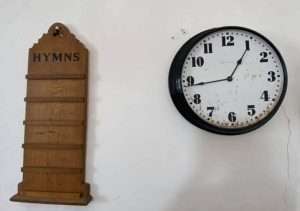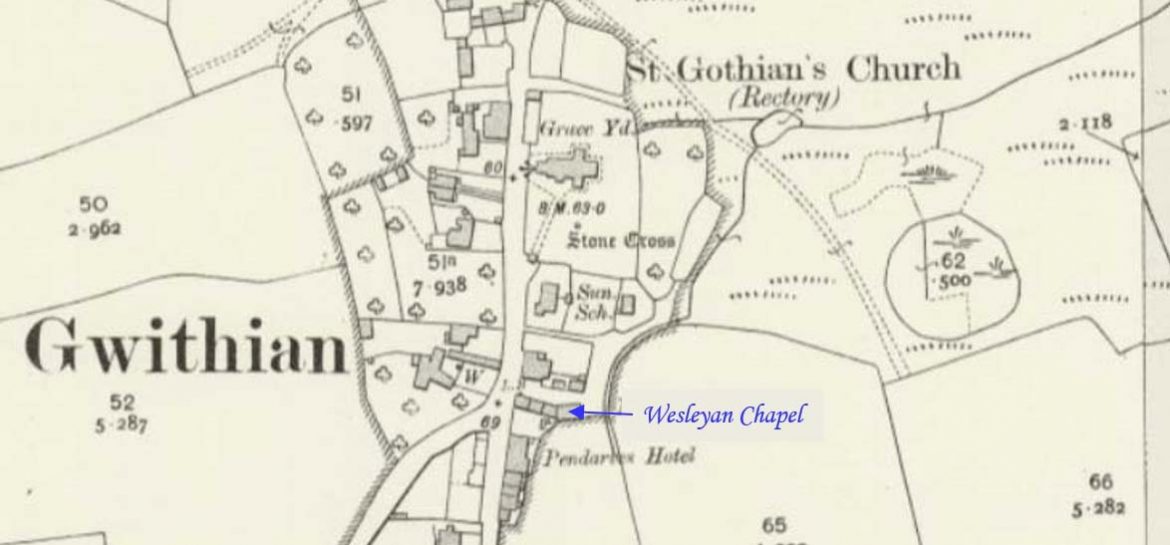
Gwithian is a coastal village in west Cornwall, three miles (5 km) north-east of Hayle and four miles (6.5 km) east of St Ives. This profile of Gwithian Wesleyan Chapel has been compiled by Jo Lewis and Tony Mansell.
The last remaining thatched chapel in Cornwall. Deed of 1771 names John Wesley as ‘Protector of the Religious Society.’. Present chapel built in 1810. The Society ceased in 1995, but the chapel was rescued in 1999 and reopened for worship with a display of documents and photographs. (Methodist Heritage)
Wesleyan chapel (up-graded to II* 1999), now privately owned. Deed of 1771 but surviving chapel thought to be c1810. Rare and beautiful vernacular example built of limewashed rubble and cob under a hipped wheat-reed thatched roof. Window opening to each side with late C19 sashes with margin panes and some coloured glass. Doorway to right of front side. Fittings long since removed (Thomas C, Gwithian Chapel 1999). Listed in Stell (b1). (Cornwall Heritage Gateway)
Earlier Chapel
A Deed of 1771 names John Wesley as ‘Protector of the Religious Society’.
No other information found apart from that the Circa 1810 chapel replaced an earlier Preaching House.
Circa 1810 Chapel
Entering Gwithian from the south, on Prosper Hill, the chapel is on the right just after the Red River pub, tucked down a side lane.
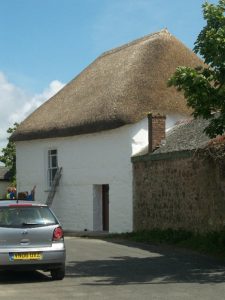 Gwithian Wesleyan Chapel, June 2008 (Photo: Terry Knight)
Gwithian Wesleyan Chapel, June 2008 (Photo: Terry Knight)
9 Jul 1810: Lease, Gwithian Wesleyan chapel. 1) Richard Hockin, the younger of Gwithian, gentleman. 2) Peter Curnow Veale, Richard Davey, Thomas Craze and John James, all of Gwithian; Joseph Carne, Roger Vivian, William Ninnis, Charles Harvey, Arundell Pryor, Henry Williams and Nathaniel Anthony, all of Phillack; trustees appointed on behalf of the Methodist Society at Gwithian. Plot of waste ground about 34 feet long by 25 feet wide upon which a Methodist chapel is to be built, with plot of waste ground adjoining the eastern end of the said chapel as far as Richard Hoskin’s right extends, all situated in churchtown, Gwithian and part of the tenement called Varnon’s. Term: 999 years. Consideration: 5 shillings and rent of 1 shilling per annum. (Kresen Kernow X1115/1)
Circa 1810: Build date. (Cornwall Heritage Gateway / Checklist of Churches in the Hayle Circuit on the 31st August 1961)
Replaced an earlier Preaching House. (Checklist of Churches in the Hayle Circuit on the 31st August 1961)
Nonconformist (Wesleyan chapel). Circa 1810. MATERIALS: painted rubble and cob walls, the lifts of the cob clearly visible; wheat-reed thatched hipped roof. PLAN: small rectangular aisle-less plan with gallery at the rear (west) end and doorway to the north wall. EXTERIOR: single-storey elevations. North entrance front has late C19 horned sash with coloured margin panes set high up on the left and doorway with [ate C19 door. Similar windows near centre of opposite wall and to centre of east end.
INTERIOR: not inspected but former list description notes: “simple interior with plain plastered walls and canopied ceiling. C19 panelled gallery front with coved cornice rostrum with choir stalls at either side and 2 flights of steps, otherwise much renewed in the C20”.
FITTINGS: replaced in 1959. Now the only original thatched Methodist chapel left in Cornwall, very much in the mould of nonconformist vernacular buildings of the Old Dissent such as the Quaker Meeting House at Come-to-Good, Kea. In a national context, this survives as a very rare and outstanding example in the vernacular tradition. Bibliography 2826 Gwithian (Charles Thomas), 1964. (British Listed Building)
1906: “Gwithian Wesleyans held their annual festival on Saturday. The teachers and scholars formed a procession, headed by the Camborne Town Band, and perambulated the village. On returning to the Towans the children were regaled with tea and buns.” (14 July 1906 – Cornubian and Redruth Times)
Chapel renovated. (Cornishman – Thursday 23 April 1908)
1932: The Wesleyan, Primitive Methodist and the United Methodist Church amalgamated to become the Methodist Church of Great Britain.
1940: Seating for 115. (David Easton, Methodist Minister and historian)
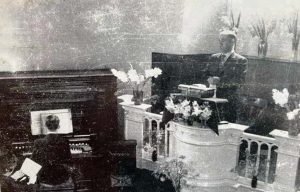 Gwithian Chapel before the 1959 renovation (Photo: Barry West)
Gwithian Chapel before the 1959 renovation (Photo: Barry West)
1959: “GWITHIAN CHAPEL Gets Grant from Historic Churches Trust. Grants totalling £10,500 to 27 historic churches and to three architecturally distinctive Nonconformist chapels were announced on Thursday by the Historic Churches Preservation Trust. They include grants of … and £125 to the thatched Gwithian Methodist Chapel, near Hayle…” (West Briton and Cornwall Advertiser – Thursday 04 June 1959)
Thursday 12th June 1969 at 3 pm: Re-opening ceremony after decoration and re-thatching.
1989: “Historic chapel needs re-thatching. An appeal been launched to fund urgent repairs to an historic Methodist chapel, the only original thatched chapel in Cornwall. Gwithian Chapel a rectangular stone and cob building of special architectural and historical interest, needs part of its roof re-thatched. £4.000 has to be raised to complete the work. The chapel is also facing a congregation crisis. There are just five members of the Gwithian Methodist Society, four of whom are into their eighties. Methodist rules stipulate there must be at least six members otherwise the society may be absorbed into a larger one. In an attempt to increase numbers the chapel secretary, Mrs Olga White (84) of Connor Downs, has been in touch with local families. She says, there is room in the chapel, little changed since it was built in 1810, for 100 people. A small wooden balcony at the back holds ten small pews and there are 11 downstairs. The Rev Edgar Daniel Camborne circuit superintendent has said there is no threat of the chapel closing… The chapel, a listed building, has had an unbroken tradition of worship for almost 180 years. John Wesley had links with the village. Mr Daniel said the church council had asked the circuit for help. He believed there was a future for the chapel.” (West Briton and Cornwall Advertiser – Thursday 14 September 1989)
1995: The Society ceased. (David Easton, Methodist Minister and historian)
1999: Put-up for action in 1999.
Keen to ensure its survival as a place of worship, Professor Charles Thomas, who attended the chapel for over 50 years and also served as chapel steward, bought the building with his son, Martin, who was baptised there.
Article about the sale. (West Briton and Cornwall Advertiser – Thursday 25 March 1999)
2006: Listed as a charity and continues in use for worship.
2007: English Heritage and the Heritage Lottery Fund (HLF) has announced an annual funding package worth £17.5 million for repairs to 153 grade I and II* listed churches and chapels across England. In Devon and Cornwall, a total of £552,000 earmarked for a range of repairs at six places of worship was announced at a rare thatched Methodist chapel in Gwithian, near Hayle, whose wheat reed thatched roof and outer walls are in urgent need of repair. In Gwithian, the Methodist Chapel is to receive £86,000. The chapel’s roof is in a poor condition, and the thatch is so worn and thin in some places that the hazel spars are exposed, and some of the eaves have weakened. This has left parts of the chapel exposed to the elements and during severe storms in autumn 2005 rainwater ran into the southern wall, made of cob (rammed earth and straw) causing partial collapse. The chapel is also in need of redecoration and repairs to window frames. The chapel forms a key part of the local community, serving nearby Hayle, Gwinear and Camborne as well as Gwithian itself. Dating to 1810, the chapel was built as a Wesleyan Methodist Chapel, and continued in use until it was put up for auction by the Methodist Church in 1999. Keen to ensure its survival as a place of worship, Professor Charles Thomas, who has attended the chapel for over 50 years and has also served as chapel steward, bought the building with his son, Martin, who was baptised there. In 2006, it was vested in a charity, and it now continues in use for worship. Dr Robert Bewley, Regional Director of English Heritage in the Southwest said: “Gwithian Methodist Chapel is a perfect example of what the Inspired! campaign illustrated. Here we have a small community fighting hard to protect this grade II* listed piece of our nation’s heritage, and important part of the local community, whose fate would have been uncertain were it not for the intervention of the Thomas family. Thatched roofs are rare among places of worship and it is important that we act quickly to preserve this feature.” (The Packet)
Used for occasional worship. Private Trust. (David Easton, Methodist Minister and historian)
It is grade 2 listed
Methodist Heritage website: http://www.methodistheritage.org.uk/gwithianchapel.htm
These photographs are included courtesy of Barry West

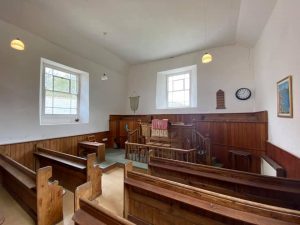
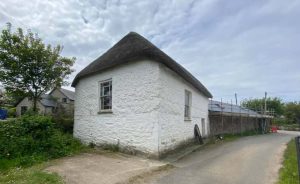


 “Persisting from the 19th century is a firmly-entrenched belief at Gwithian that any visiting Local Preacher had, and still has, a right to stable a horse during a Chapel service in the yard of the Pendarves Arms, next door. The provision is not contained in the 1810 Lease to Trustees but may have been set in a (lost) document from Peter Curnow Veale, one of the 1810 trustees who lived next-door at what is now Churchtown House and owned a public house where the Pendarves Arms was subsequently built. This photograph was taken in late 1959 or in early 1960 by Mr Wakeford, Hayle, partly to illustrate the tradition. The rider is Mr George Siddons of Wheal Alfred, Hayle, who was born in 1873, was admitted as a Local Preacher in 1893 (receiving his 70-year certificate in 1963) and died aged more than 90. On this occasion, George Siddons was brought over to Gwithian by Mr Michael B Williams, one of the Trustees of the Chapel, and the horse was lent for purposes of the picture by Mrs Nellie Start, Hayle. Mr Siddons, a spry 86-year-old, needed no encouragement to spring into the saddle. His last service at Gwithian Chapel was on Sunday 18th March 1962, when he was 89, and could still preach a vigorous sermon.”
“Persisting from the 19th century is a firmly-entrenched belief at Gwithian that any visiting Local Preacher had, and still has, a right to stable a horse during a Chapel service in the yard of the Pendarves Arms, next door. The provision is not contained in the 1810 Lease to Trustees but may have been set in a (lost) document from Peter Curnow Veale, one of the 1810 trustees who lived next-door at what is now Churchtown House and owned a public house where the Pendarves Arms was subsequently built. This photograph was taken in late 1959 or in early 1960 by Mr Wakeford, Hayle, partly to illustrate the tradition. The rider is Mr George Siddons of Wheal Alfred, Hayle, who was born in 1873, was admitted as a Local Preacher in 1893 (receiving his 70-year certificate in 1963) and died aged more than 90. On this occasion, George Siddons was brought over to Gwithian by Mr Michael B Williams, one of the Trustees of the Chapel, and the horse was lent for purposes of the picture by Mrs Nellie Start, Hayle. Mr Siddons, a spry 86-year-old, needed no encouragement to spring into the saddle. His last service at Gwithian Chapel was on Sunday 18th March 1962, when he was 89, and could still preach a vigorous sermon.”
